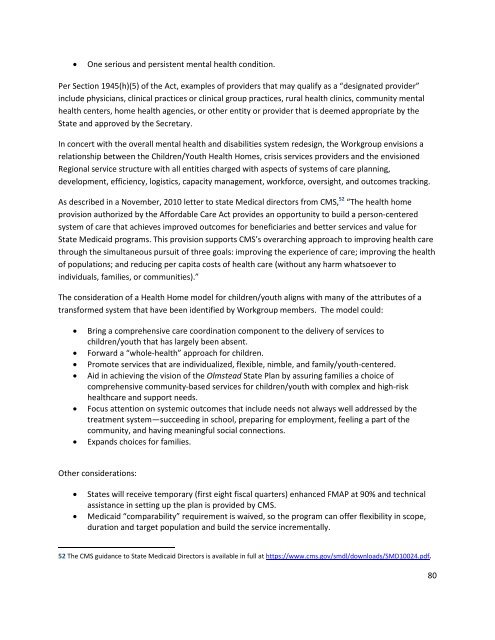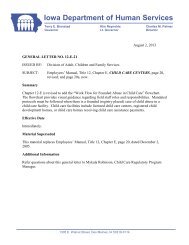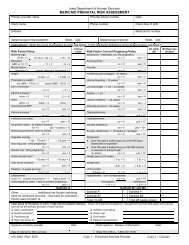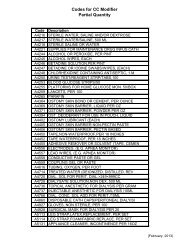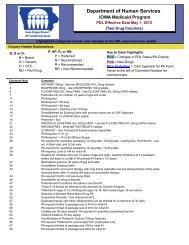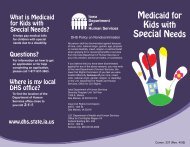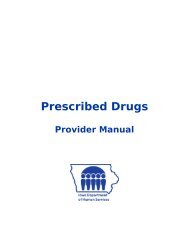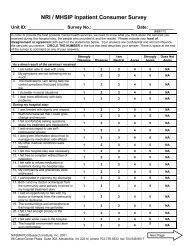Iowa Mental Health and Disability Services System Redesign Interim ...
Iowa Mental Health and Disability Services System Redesign Interim ...
Iowa Mental Health and Disability Services System Redesign Interim ...
- No tags were found...
You also want an ePaper? Increase the reach of your titles
YUMPU automatically turns print PDFs into web optimized ePapers that Google loves.
• One serious <strong>and</strong> persistent mental health condition.<br />
Per Section 1945(h)(5) of the Act, examples of providers that may qualify as a “designated provider”<br />
include physicians, clinical practices or clinical group practices, rural health clinics, community mental<br />
health centers, home health agencies, or other entity or provider that is deemed appropriate by the<br />
State <strong>and</strong> approved by the Secretary.<br />
In concert with the overall mental health <strong>and</strong> disabilities system redesign, the Workgroup envisions a<br />
relationship between the Children/Youth <strong>Health</strong> Homes, crisis services providers <strong>and</strong> the envisioned<br />
Regional service structure with all entities charged with aspects of systems of care planning,<br />
development, efficiency, logistics, capacity management, workforce, oversight, <strong>and</strong> outcomes tracking.<br />
As described in a November, 2010 letter to state Medical directors from CMS, 52 “The health home<br />
provision authorized by the Affordable Care Act provides an opportunity to build a person-centered<br />
system of care that achieves improved outcomes for beneficiaries <strong>and</strong> better services <strong>and</strong> value for<br />
State Medicaid programs. This provision supports CMS’s overarching approach to improving health care<br />
through the simultaneous pursuit of three goals: improving the experience of care; improving the health<br />
of populations; <strong>and</strong> reducing per capita costs of health care (without any harm whatsoever to<br />
individuals, families, or communities).”<br />
The consideration of a <strong>Health</strong> Home model for children/youth aligns with many of the attributes of a<br />
transformed system that have been identified by Workgroup members. The model could:<br />
• Bring a comprehensive care coordination component to the delivery of services to<br />
children/youth that has largely been absent.<br />
• Forward a “whole-health” approach for children.<br />
• Promote services that are individualized, flexible, nimble, <strong>and</strong> family/youth-centered.<br />
• Aid in achieving the vision of the Olmstead State Plan by assuring families a choice of<br />
comprehensive community-based services for children/youth with complex <strong>and</strong> high-risk<br />
healthcare <strong>and</strong> support needs.<br />
• Focus attention on systemic outcomes that include needs not always well addressed by the<br />
treatment system—succeeding in school, preparing for employment, feeling a part of the<br />
community, <strong>and</strong> having meaningful social connections.<br />
• Exp<strong>and</strong>s choices for families.<br />
Other considerations:<br />
• States will receive temporary (first eight fiscal quarters) enhanced FMAP at 90% <strong>and</strong> technical<br />
assistance in setting up the plan is provided by CMS.<br />
• Medicaid “comparability” requirement is waived, so the program can offer flexibility in scope,<br />
duration <strong>and</strong> target population <strong>and</strong> build the service incrementally.<br />
52 The CMS guidance to State Medicaid Directors is available in full at https://www.cms.gov/smdl/downloads/SMD10024.pdf.<br />
80


